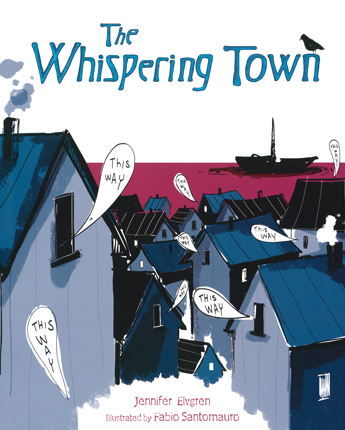Full Text Reviews: Bulletin for the Center... - 05/01/2014 Set in 1943 in Nazi-occupied Denmark, this striking picture book tells the story of a community of townspeople who work together to aid Jews hiding from the Nazis. As the story opens, Anett’s mother informs Anett that there are “new friends in the cellar” and sends the girl down with breakfast for Carl and his mother, who will soon depart by boat. When Anett gathers supplies from likeminded villagers, the baker provides extra bread, the librarian provides extra books, and the farmer provides extra food (“‘Wish them well,’ he whispered back, giving me extra eggs”). Soldiers begin to search for hidden Jews in the village, and it looks like the dark of the moonless night will keep Carl and his mother from making it to the harbor; fortunately, Anett comes up with the idea of directing the pair through whispers, and the villagers stand on their doorsteps and whisper “This way” to guide the two to a waiting boat. Elvgren’s focused, unsentimentalized narrative is an ideal selection for introducing younger children to the many who stood up to do what was right during the Nazi regime. The spare storytelling style is perfectly matched with the sophisticated yet accessible illustrations, composed of black lines, fields of digital color, and scratchy pen details. A limited palette wherein grays and blues dominate plays to the mystery of the story while the contrasting splashes of dark red add interest. An author’s note provides background information and links the events of the story to an actual occurrence in the fishing village of Gilleleje. This is a notable early introduction to the Danish resistance that deserves wide readership. HM - Copyright 2014 The Board of Trustees of the University of Illinois. Booklist - 05/01/2014 *Starred Review* Based on a true incident, this is the story of two families, one Danish, the other Jewish. Young Anett is told by her mother, there are new friends in the cellar. This is no surprise to the girl; the cellar is where Danish Jews are hidden from the Nazis. The new boy, Carl, and his mother are to remain hidden for two nights, until a boat can take them to Sweden. Until then the other villagers provide bread and eggs and even books. The moonless nights make it difficult to evacuate the duo, yet as the Nazis come closer, it becomes clear that they must somehow make their way to the harbor. Then Anett has an idea. That night, the villagers stand in the doorways of their houses, each whispering, this way, and forming a chain that leads Carl and his mother to the first step toward safety. The illustrations have the bold look of a graphic novel and use oversize figures to command attention. Both author and illustrator do an excellent job of bringing both the horror and humanity of this story to a level younger children can understand, and there is much of both: Nazis pounding on doors; Carl giving Anett his most prized possession, a heart-shaped stone, a last gift from his father. An unusual and strong addition to Holocaust literature. - Copyright 2014 Booklist. Loading...
|



